|
Orchid
News # 34
|
|
XIX WOC
|
Polycycnis, Acineta, Houlletia, Peristeria and Cirrhaea
The subtribe Stanhopeinae consists of about
26 genera with a total of some 400 species.
Acineta Lindl.
Acropera Lindl. considered a subgenus of Gongora
Archivea Christenson & Jenny known
only from dried material, lost, monospecific
Braemia Jenny monospecific genus, segregate
from Polycycnis
Brasilocycnis Gerlach synonym of Lueckelia,
segregate from Polycycnis
Ceratochilus Loddiges synonym of Stanhopea
Cirrhaea Lindl.
Coeliopsis Rchb.f. monospecific genus
Coryanthes Hooker
Embreea Dodson segregate from Stanhopea
Endresiella Schlechter synonym of Trevoria
Gerlachia Szlachetko segregate from Stanhopea
Gongora Ruiz & Pavon
Gorgoglossum Schlechter monospecific, synonym for Sievekingia
Horichia Jenny monospecific genus
Houlletia Brongniart
Jennyella Lückel & Fessel segregate
from Houlletia
Kegelia Rchb.f. synonym for Kegeliella
Kegeliella Mansfeld
Lacaena Lindl.
Lueckelia Jenny monospecific genus, segregate
from Polycycnis
Lueddemannia Rchb.f.
Lycomormium Rchb.f.
Meliclis Rafinesque synonym of Coryanthes
Nauenia Rchb.f. synonym of Lacaena
Neippergia Ch.Morren synonym of Acineta
Panstrepis Rafinesque synonym of Coryanthes
Paphinia Lindl.
Peristeria Hooker
Polycycnis Rchb.f.
Polycycnopsis D.L.Szlachetko segregate from Polycycnis
Schlimia Planchon & Lindl.
Scleropteris Scheidweiler synonym of Cirrhaea
Sievekingia Rchb.f.
Soterosanthos Lehmann ex Jenny monospecific
segregate from Sievekingia
Stanhopea Frost ex Hooker
Stanhopeastrum Rchb.f. monospecific
segregate from Stanhopea
Tadeastrum Szlachetko segregate from Stanhopea
Trevoria F.C. Lehmann
Vasqueziella Dodson monospecific genus
Some of those genera are very well known in culture and some species of those genera are widely distributed in culture. Stanhopea- and Gongora-species are in most cases easy to cultivate and are flowering freely even under not optimized conditions. Of several of the genera in the subtribe monographic treatments or revisions have been published in the last 20 years
Acineta Lindl. 2 recently published partial
treatments
Archivea Christenson & Jenny monospecific
Braemia Jenny monospecific
Coeliopsis Rchb.f. monospecific
Coryanthes Hooker monographic treatment by GERLACH
Embreea Dodson part of monographic treatment of Stanhopea
Gongora Ruiz & Pavon monographic treatment
by JENNY
Horichia Jenny monospecific
Lacaena Lindl. monographic treatment by JENNY
Lueckelia Jenny monospecific
Lueddemannia Rchb.f. monographic treatment by JENNY
Paphinia Lindl. monographic treatment by JENNY
Sievekingia Rchb.f. monographic treatment by JENNY
Soterosanthos Lehmann ex Jenny monospecific
Stanhopea Frost ex Hooker monographic treatment by JENNY
Vasqueziella Dodson monospecific
In case of monospecific genera like Soterosanthos Lehmann
ex Jenny, Coeliopsis Rchb.f., Archivea Christenson & Jenn,
revision is not necessary or is integrated in a treatment
of the next allied larger genus. New species of the
formerly monospecific Embreea Dodson and Lueddemannia Rchb.f.
have been described in the last couple of years. Coeliopsis, Lacaena, Lycomormium and Peristeria are
considered by some authors to form an own subtribe,
described as Coeliopsidiinae.
Stanhopeastrum, Tadeastrum and Gerlachia are
segregates from Stanhopea, described or reactivated
in case of Stanhopeastrum in 2006 by Dariusz SZLACHETKO.
The segregations are based on pure morphological features
and have done before on the level of subgenera and
sections by GERLACH. Accepting them would mean to reactivate
or lift to generic level quite a few other groups like Acropera (subgenus
in Gongora), Portentosa (subgenus in Gongora).
Basically it would not change the picture of the subtribe
as it is also supported by DNA-data. But it would shift
divisions from the subgeneric level to a generic level
and would create a great number of new names and synonyms
without any new perception. DNA-data showed that some
species formerly integrated in known genera have been
correctly separated in own genera, e.g. Polycycnis or Houlletia
vittata to Braemia vittata, Polycycnis
breviloba to Lueckelia breviloba and Stanhopea
rodigasiana to Embree rodigasiana.
For several reasons
it will be difficult to revise the remaining few genera in the subtribe
with more than a few species, this is true for the genera Acineta,
Cirrhaea, Polycycnis, Houlletia and Peristeria. First of
all most of the species of those genera are seldom seen in cultivation
and the plants are notoriously cultivated without any information concerning
origin, the best we know is very often only “South-America”
or “Peru”. Plants are seldom in cultivation because they
are not easy to find in nature, only some of them are forming mass-populations,
most are rather outsiders. The species are often difficult to cultivate
successfully and some of them do not have very attractive flowers (e.g.
Cirrhaea-species). Another reason are CITES regulations.
On the other hand these plants are also comparatively
seldom seen in herbaria, so we miss desperately material.
Based on the fact that genera like Acineta, Polycycnis or Cirrhaea seems
to be generally difficult from a taxonomical point
of view and together with the above mentioned reasons,
it’s understandable that we don’t have
yet comprehensive treatments available.
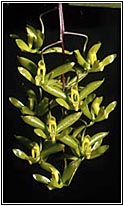 Cirrhaea saccata |
Cirrhaea Cirrhaea is a genus endemic for Brazil, 21 species and varieties have been published since its first description by LINDLEY in 1832 with the type species Cirrhaea loddigesii. Almost all of those species are rather similar, some are separated only by the colour of the flowers. The problem started when plants showed up with flowers of two different species on the same inflorescence. Although it seems not to be a question of unisexual flowers like in the genus Catasetum, it certainly ended the dream of an easy task to keep the few species of this relatively small genus separated. The genus is in desperate need of a proper revision. |
|
Polycycnis
ornata Parsons
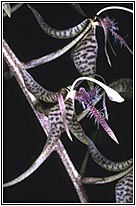 |
Polycycnis
Heinrich Gustav REICHENBACH described 1855 the genus Polycycnis based on Cycnoches barbatum Lindley, type of the genus is Polycycnis barbata (Ldl.) Rchb.f. Two species have been removed and recombined in own, monospecific genera based on morphological and DNA-data, Polycycnis vittata to Braemia vittata by JENNY in 1985 and Polycycnis breviloba to Lueckelia breviloba by JENNY in 1999. The later was described in the same year also as Brasilocycnis breviloba, the publication was a few weeks later than the one of Lueckelia and so the name Brasilocycnis became a synonym. In an article published very recently SZLACHETKO separated 4 |
Polycycnis
tortuosa
 |
| species as own genus Polycycnopsis. Some of the about 20 described species are extremely similar and it is questionable whether they represent “good” species at all. |
|
.
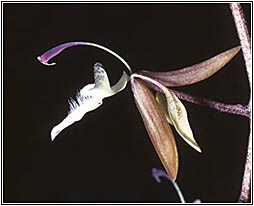 Polycycnis gratiosa |
|
Acineta
chrysantha
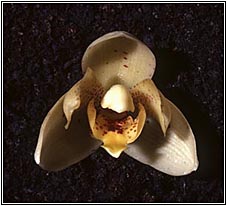 |
Acineta Unlike Cirrhaea, Acineta is a more popular genus in culture, especially in South- and Central America, this fact does’nt mean of course that the cultivated plants are labelled correctly. Acineta was described by John LINDLEY in 1843, type species of the genus is Acineta superba which was named by REICHENBACH in 1863 and which is based on the old Anguloa superba Humboldt, Bonpland & Kunth from 1815. A total of about 31 species and varieties has been named and a first treatment of the genus by Rudolf SCHLECHTER was published in 1917 in Orchis. Two more modern but incomplete treatments were published by GERLACH in 2001 and |
Acineta
humblottii
 |
| CHRISTENSON in 2006. Vegetative all species of the genus are very similar, the main differences are found in the morphology of the lip which is not visible on most of the published illustrations. |
|
Houlletia
lansbergii
 |
Houlletia
Houlletia was described by A.BRONGNIART in 1842 with the type species Houlletia stapeliaeflora. Today we have about 27 species and varieties named, most of the varieties are representing only colour forms, some taxa like Houlletia lansbergii Rchb.f. and Houlletia trigrina Linden ex Lindley are representing one and the same species. One species, Houlletia vittata (later Polycycnis vittata) has been removed as Braemia vittata in 1985. Rudolf SCHLECHTER published 1915 a first treatment of the genus and separated the species known at this time in two sections, Euhoulletia and Neohoulletia, he wrote that perhaps the two sections should be separated in own genera. SCHLECHTER’s opinion was based on pure morphological features, recent DNA-data are supporting his view |
Houlletia
tigrina Parsons
 |
| and so the Neohoulletia-group was separated as Jennyella by Emil LUECKEL and Hans FESSEL in 1999, two other species have been moved to Jennyella by SZLACHETKO in 2007 |
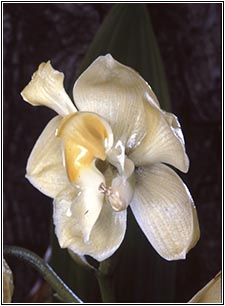
Jennyella lowiana
|
Peristeria
elata
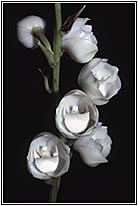 |
Peristeria
Peristeria is very well known for one species which is in appendix 1 of the CITES list in spite of the fact that the plant is not endangered: Peristeria elata, the Dove-Orchid. The species grows terrestrially in deforested areas and such areas are becoming more and more abundant. The genus was described by William Jackson HOOKER in 1843, type species is Peristeria elata. Since HOOKER about 23 species and varieties have been described. As in Acineta the differences between the species are |
Peristeria
lindenii Parsons
 |
| mainly in the structure of the lip which is normally only visible in parts ion illustrations.Additionally some of the species are extremely variable in colour.Peristerias – with exception of Peristeria elata – are very seldom seen in cultivation and they seem to be difficult to keep alive for a longer time. |
Conclusion:
Of some of the genera in the subtribe we need desperately
a monographic treatment and in order to do so we depend
on material and information about those plants. We
need dried or pickled flowers and we need data about
origin, habitat and distribution. Information about
the pollinators would be important, although such information
is difficult to obtain and depends entirely on field
work. Fragrance analysis can be done from cultivated
plants, assuming that the plants are in flower and
the necessary equipment is available, also DNA-data
can be obtained from cultivated plants. In all those
cases it is paramount to know what species was analyzed
or studied and therefore the particular plant needs
to be documented, either in form of dried material,
pickled flowers and/or pictures.
Photos: R. Jenny
|
Any
kind of reproduction (print, digital or anyone)
of any type of material of this site: texts,
layout, photos, images and others - is
strictly forbidden without previous written permission of the authors. Any solicitation or information by the e-mail:bo@sergioaraujo.com |